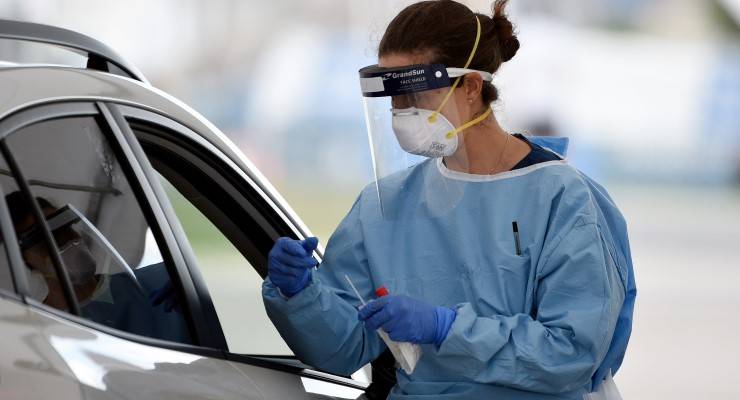
Taken all in all, the response of Australia’s governments to COVID-19 has been well-judged and (at least so far) relatively successful. Borders were closed before the numbers of incoming cases became unmanageable, and we got to lockdown (or Level 3) before community transmission got out of hand.
Messaging, on the other hand, has been a fiasco. We’ve had statements that restrictions such as school closures are counterproductive, followed only a few days later by the imposition of those very restrictions. Precautions such as widespread testing and facemasks were said to be unnecessary and unhelpful, when the truth was we didn’t have enough test kits or equipment to follow the most protective policies.
The confusion has been even greater in relation to policy objectives. Terms like “herd immunity”, “flattening the curve” and “eradication” are being bandied about, with no clear idea of the distinctions between them.
Eradication, the policy being pursued by the Ardern government in New Zealand, is clear enough. Full scale restrictions stay in place until the number of cases is so low that it is possible to isolate and test everyone who has been in contact with a newly detected case. Border quarantine is the same: compulsory until we have a test definitive enough to clear new arrivals. In this context, isolated outbreaks might continue for some time, but the objective is simple.
Herd immunity is a little more complicated, but has its own brutal logic: if enough people catch the disease, and those who survive it are immune to infection, eventually there won’t be enough vulnerable people to keep the disease spreading.
But where does “flattening the curve” fit in? To understand this, it’s necessary to appreciate one basic fact about the models of exponential growth which underlie the modelling on which everyone is relying.
Any exponential process, from economic growth to animal reproduction to the spread of a pandemic, relies critically on a single parameter, usually denoted “R”. This is the rate at which each instance of the phenomenon being modelled gives rise to a new one.
Most attention focuses on the case when R is greater than one. This leads to exponential growth which continues until the process hits some kind of constraint.
In the case of epidemiology, R is the effective reproduction rate, which is the number of new infections generated by each existing case. If R is initially greater than one, the number of cases will grow until it is constrained by herd immunity.
By contrast, if measures such as lockdown push R below one, the number of cases drops over time, eventually reaching zero. A variety of animal and plant diseases have been eliminated using stringent quarantine measures, with destruction of affected herds and crops. But human diseases have rarely been eliminated in the absence of vaccines, and then only with very stringent isolation and quarantine.
What’s critical is that there is really no middle ground. Except if R is exactly equal to one (this is what mathematicians call a “null” or “zero” probability event), the process either declines to zero or grows until it hits a constraint.
The advocates of “flattening the curve” started from the assumption that it would be impossible to push R below one (implicitly because they did not believe that democratic societies would tolerate a China-style lockdown). So, the best thing to do was to push R nearer to one. That would “slow the spread” (the government’s official slogan, at least in advertising), but would still ultimately entail exposing a substantial proportion of the population.
But the evidence has shown that lockdowns work. Everywhere they have been introduced, the rate of new infections has started to decline within a few weeks, long before herd immunity can have played a role. The earlier and more rigorously restrictions are imposed, and the more comprehensive the testing regime, the faster the decline.
The result is that our leaders are finally talking about eradication. A few days ago, deputy chief medical officer Paul Kelly announced that, thanks to lockdown measures, Australia was “on the cusp” of defeating the disease by reducing the rate of new infections per existing case below 1. Yesterday, Health Minister Greg Hunt finally described our goal as “effective eradication”, a term chief medical officer Brendan Murphy had carefully avoided.
Eradication won’t be easy. Until it is clearly established, we will need to maintain controls sufficient to hold R below one for the population as a whole, and be ready to reimpose full lockdown whenever there is an isolated outbreak. Even after that we will need strict quarantine until a vaccine is developed or until other countries can also achieve and verify eradication.
After that will come the task of post-emergency reconstruction — deciding to what extent we can and should recreate the decaying neoliberal economy with which we began the crisis, as well as what kinds of alternatives we can pursue.








But does “eradication” mean that if people from a virus-free country venture to another country which hasn’t managed to eradicate the virus (and surely not all countries will), they might start the whole process off again?
Not if the travelling person, upon return, enters a strictly enforced period of quarantine accompanied and followed by reliable testing before being allowed to resume life in the community. If this were not done for every person arriving in Australia, the period of eradication would soon give way to a new period of reproduction. That’s my understanding of it.
Yes woopwoop, it does. Chilly is right, full quarantine on return, probs for a month just to make sure. International travel won’t be available to all as it has been, it will probably become an essential travel only option, except for travel to other infection free countries.
And what travel is essential? Not much really, can’t think of anything at all.
Expect travel treaties between countries down the track. Oz and NZ first, if we get lucky.
So it’s goodbye to inbound international tourism, education etc. Quite a blow to the economy.
Eradication seems a noble goal, but when there’s asymptomatic carriers and limited requirements for testing, I feel there’s reasons to doubt the political urge to say that Australia is on top of it – at least currently anyway. Is there going to be enough political will to do the requisite testing to make such pronouncements?
Not surprising that the most sensible commentary would come from John Quiggin. Along with Prof Raina McIntyre and Dr Norman Swan they are beacons of clarity.
Our Chief Medical Officer has been just competent, but sometimes less so, and with ScoMo sometimes incoherent in messaging.
I haven’t heard those reports where they actually uttered “eradication” but glad to hear it. It must be our goal, every other option sees lockdown for years rather than months. A vaccine may be 12 months at best or never at worst.
Go for zero, and yes, after that no international travel until a vaccine is found. Full blown quarantine for all arrivals of citizens, gradual expansion to other countries with zero infections. It may be just us, NZ and a few south Pacific islands for some time.